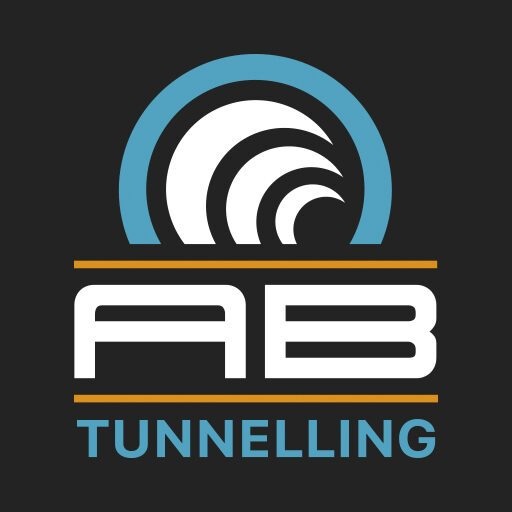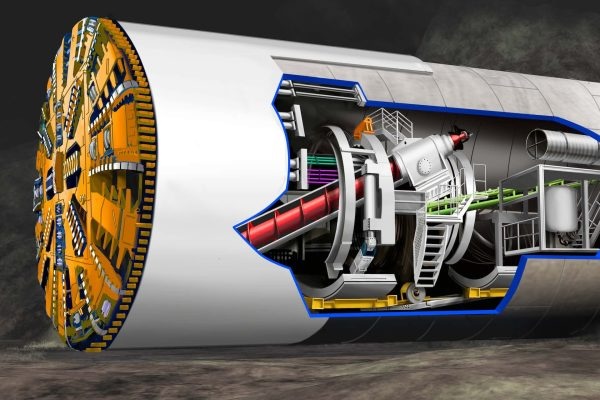TBM s (Tunnel Boring Machines), commonly called “mechanical moles”, or, more technically, full-section mechanical cutters, have revolutionized the approach to tunnel construction, providing a precise and efficient mechanized solution compared to any other traditional method of digging based on manual labor. TBMs are complex and versatile machines capable not only of drilling, but also, thanks to an integrated system, of disposing of the debris generated by the excavation process and, depending on the conditions and needs, also to simultaneously assembly the precast tunnel segments.
Rotating head and cutting tools
In the front part of each Tunnel Boring Machine there is a sophisticated rotating head (cutterhead), also called milling head, connected behind the very important main bearing which ensures the rotation and application of the longitudinal thrust. The front of the rotating head houses a series of cutting tools (rippers, scrapers and disc cutters) designed according to the composition and geomechanical characteristics of the front to be faced. In the design of the rotating heads of TBM intended for predominantly rocky terrain, the choice of materials for the realization of disc cutters, plays a crucial role in the effectiveness and performance of the machines themselves. In particular, steel is one of the most used materials in the production of cutters for its characteristics of strength, hardness and machinability.
But the steel composition of the cutting tools must be carefully balanced to ensure the best properties. A recent study published in the magazine Strength of Materials reiterated the importance of the “mix of ingredients” of steel alloy for TBM Cutters. The authors highlighted once again how the right balance of elements such as carbon, chromium and vanadium, is decisive in giving the sharp hardness, toughness and resistance to the extreme stresses of the excavation and to maintain and increase the performance of the mechanical mole.
Another essential factor for TBM cutting tools is their geometry, understood as the angle of inclination and configuration of the tip (or the profile, in the case of rotating discs), which must be optimized to adapt to the characteristics of soils of various nature (rocky, compact or fractured, sandy, etc.). A perfect example comes from the characteristics of AB Tunnelling’s RingX ® cutting discs, for which steel alloy balance and structure have been studied throughly and with great accuracy and whose geometry has been refined to the highest level.
Thrust system and debris disposal system
The thrust system of the TBM, essentially consisting of motor, anchoring devices (grippers) and hydraulic jacks, is obviously the driving heart of the machine. As well outlined in a study published in the magazine Machines, hydraulic jacks, in particular, should be designed with very high precision levels in order to provide the necessary thrust to advance in the ground, while maintaining extremely accurate control of speed and pressure. As for the debris disposal system, which may include conveyor belts or augers, it must be designed to handle large volumes of material efficiently, while ensuring the safety of operators. According to a study published in Automation in Construction, the system should:
– consider a preventive computational simulation to obtain the best configuration;
– be fully automated both in the control and in the flow of materials;
– be equipped with energy recovery devices capable of exploiting the kinetic energy of the moving material to reduce overall consumption;
– be monitored in real time in all its aspects to enable operators to quickly identify any problems and to intervene promptly.
In addition to these specific optimizations, the study recommends a holistic approach to system design that takes into account all components and processes of the machine, so as to develop an efficient material transport technology, reliable, safe and sustainable, and which contributes to reducing overall excavation costs with TBM.
Tail shield and backfilling system
The filling system (backfilling) of the “annular gap” that is created between the excavated section of the tunnel and the external diameter of precast lining (often carried out simultaneously by the TBM itself), are an additional fundamental and nevralgic part of the mechanical mole. Backfilling takes place through the injection of two-component mixtures (cement, bentonite, water and additives and silicate) by means of pumps through the precast segments or through the TBM tail shield. Several studies published in authoritative magazines emphasize the importance of increasingly accurate research on the quality of mixtures, additives and injection techniques for a correct, effective and long-lasting filling in the annular gap.
A fundamental role in the backfilling system, among other things, is played by the so-called “tail brushes“, mounted on the shield in the rear area of the Tunnel Boring Machine, intended to confine evenly the two-component mixtures, thus ensuring the structural stability and waterproofing of the tunnel. AB Tunnelling’s tail brushes, with their sophisticated design guarantee high wear resistance, excellent capability to retain tail skin grease, adequate flexibility and perfect mixture allocation.
TBM for each operating situation
TBM solutions have evolved steadily over time to meet all kinds of environmental and geological challenges. Tunnel Boring Machines must be able to operate in very different geological conditions, such as, for example, in the presence of aquifers, soft ground or in extremely hard rock. This has led to the development of several variants of mechanical mole, each optimized to address specific challenges. TBM EPBs (Earth Pressure Balance), for example, are designed to maintain balance by using the excavated material itself to exert pressure on the excavation front, thus reducing the risk of subsidences or collapsing. These adaptations require sophisticated engineering and an accurate analysis and understanding of the properties of the terrain.
TBM: Environmental and social benefits
In addition to the advantages in terms of efficiency and speed of implementation, the evolution of TBM brings significant environmental and social benefits. The reduction in construction time and surface impact minimises disruption to surrounding communities, while the increasing ability to operate in a safe and controlled manner reduces the risk of accidents at the work site. In addition, the precision and efficiency of TBM enables more sustainable management of natural resources, reducing the amount of material extracted and the energy consumption needed to complete a construction project.
Tunnel Boring Machine: Perspectives and future challenges
Despite several positive features of the current Tunnel Boring Machines, they still have ample room for improvement. The start-up and maintenance costs, for example, are still high, requiring highly qualified personnel to manage operations.
The current researches and studies bode positively for the future. Among other things, high capability and “Green TBMs” are being studied, which will further reduce the construction time of the tunnels allowing to realize even particularly complex projects in relatively short periods.
The implementation of increasingly advanced sensors and remote monitoring systems will greatly contribute to reducing operating costs and increasing the efficiency of mechanical moles, as well as improving safety aspects and gradually optimising the prevention of dangerous situations and accidents at work.
In an article published in Automation in Construction it is emphasized that the introduction of artificial intelligence and robotic systems will make the Tunnel Boring Machine increasingly autonomous, able to make real-time decisions and adapt to changing operating situations and ground conditions without direct human intervention.
Research is also focusing on the processing of mechanical moles capable of operating in extreme environments, such as particularly hard soils or under very high pressures. These types of machines will open new avenues for the exploration and exploitation of hitherto inaccessible resources.
Moreover, as evidenced by a study on Renewable and Sustainable Energy Reviews, innovative solutions are being tested to mitigate the environmental impact of mechanical moles, such as the integration of systems for recycling excavated materials directly into the machine or the use of renewable energy sources to power the engines. In addition, research is focusing on the optimization of excavation processes to minimize waste and evolve the energy efficiency of processes.
Another cutting-edge area of research is being applied to reducing machine downtime and increasing TBM availability to maximize operational efficiency. From this point of view, the evolution of the key components of the machine, such as cutting tools, tail brushes and integrated propulsion and debris disposal systems, will be fundamental. Moreover, the use of predictive technologies based on data analysis will allow a more effective preventive maintenance, minimizing unplanned downtime.
In summary, one can conceivably imagine that the next developments of the Tunnel Boring Machine will not only transform the way underground infrastructure is built, but also that will contribute to positively shaping the future of urban mobility, resource management and environmental sustainability.

